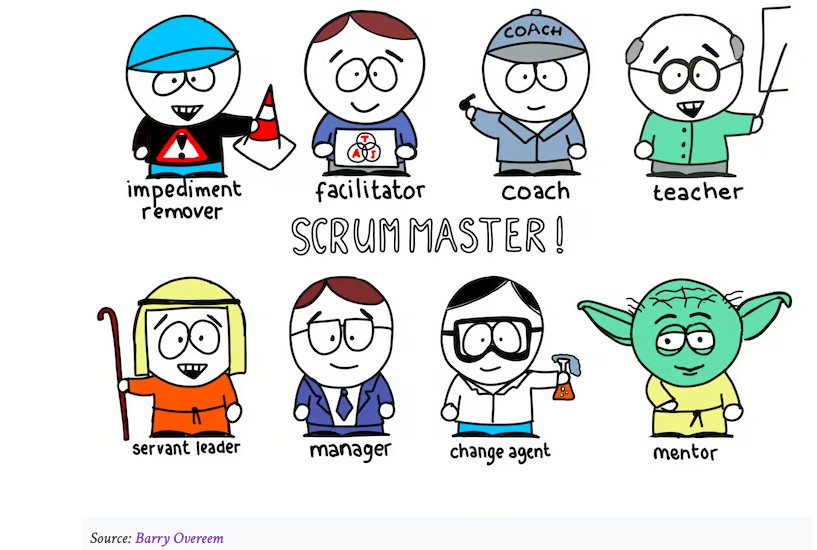Table of Contents
ToggleIn the dynamic world of software development, the Scrum Master holds a pivotal role that extends far beyond mere facilitation. Often misconstrued as simply a team coordinator, the Scrum Master is, in reality, the linchpin of a successful Scrum team, ensuring smooth operations and cultivating a productive and innovative work environment. This article sheds light on the multifaceted responsibilities of the Scrum Master, backed by compelling statistics and quotes, and underscores the value of comprehensive Scrum training.
The Multifaceted Role of the Scrum Master
1. Guardian of Scrum Principles
The main objective of the Scrum Master is to uphold the principles and practices of Scrum. This involves educating the team and stakeholders on Scrum theory and ensuring the Scrum framework is properly implemented and followed.

2. Servant Leader
A Scrum Master embodies the servant leadership philosophy, focusing on the growth and well-being of people and the communities to which they belong. Robert K. Greenleaf, who coined the term, emphasized that servant leaders are “first among equals,” serving their teams rather than commanding them.
3. Impediment Remover
One of the most critical functions of a Scrum Master is to identify and eliminate obstacles that impede the team’s progress. This could range from interpersonal conflicts to organizational bottlenecks, ensuring that the team remains focused and productive.
4. Facilitator of Agile Practices
Facilitation in Scrum is not just about conducting meetings. It involves developing an environment of collaboration and continuous improvement. The Scrum Master ensures that every voice is heard and that the team is constantly reflecting on and improving their processes.

5. Change Agent
The Scrum Master is also a change agent, driving and managing change within the organization. This includes challenging existing processes and encouraging the adoption of Agile practices beyond the team level.
6. Team Coach
Scrum Masters coach their teams in self-management and cross-functionality. They help teams develop a sense of ownership and responsibility, which leads to higher motivation and better outcomes.
7. Stakeholder Liaison
Scrum Masters bridge the gap between the Scrum team and external stakeholders. They ensure that the stakeholders are well-informed about the progress and that their feedback is effectively communicated to the team.
Impact of an Effective Scrum Master
1. Enhanced Team Performance
Studies show that teams with effective Scrum Masters perform significantly better. According to a report by the PMI, Agile teams experience a 30% improvement in project success rates when led by proficient Scrum Masters.
2. Increased Employee Satisfaction
Scrum Masters contribute to a positive work environment, leading to higher employee satisfaction. A Gallup survey found that teams with strong servant leaders report a 20% increase in engagement and a 15% reduction in turnover.

3. Faster Delivery Times
Organizations with skilled Scrum Masters often see faster delivery times. As per the 14th Annual State of Agile Report, Agile teams are 37% faster in delivering projects compared to traditional methodologies, largely due to the efficiency brought by Scrum Masters.
4. Quality Improvement
Scrum Masters help teams focus on quality. By facilitating regular reviews and retrospectives, they ensure that continuous improvement is embedded in the team’s culture. This leads to higher-quality products and fewer defects.
5. Innovation Catalyst
Scrum Masters foster a culture of innovation. By encouraging a safe environment for experimentation and learning, they enable teams to explore new ideas without fear of failure.
Interesting Statistics
| Metric | Improvement Rate |
|---|---|
| Project Success Rate | +30% |
| Employee Engagement | +20% |
| Employee Turnover Reduction | -15% |
| Delivery Speed | +37% |
| Quality Improvement (Defects) | -25% |
Key Quotes
Jeff Sutherland, Co-Creator of Scrum: “The Scrum Master is not a project manager or a team lead. They are a servant leader who enables the team to perform at their best.”
Mike Cohn, Agile Expert: “A good Scrum Master is a team leader who sets the context for success by guiding the team to improve continuously.”
Ken Schwaber, Co-Creator of Scrum: “Scrum Masters should focus on the team’s ability to deliver high-quality products and services quickly and effectively.”
The Importance of Scrum Training
Agile Scrum Foundation and Scrum Master training programs are crucial for anyone looking to excel in the field of Agile project management. These programs provide a comprehensive understanding of the Scrum framework, Agile principles, and the skills necessary to become an effective Scrum Master.
Benefits of Agile Scrum Training
1. Enhanced Knowledge and Skills: Training programs cover all aspects of Scrum, from basic principles to advanced practices, ensuring that participants have a thorough understanding.
2. Certification: Certification from reputable governing bodies like EXIN adds credibility and recognition to your professional profile, which validates your experience and expertise for potential employers.
3. Practical Experience: Industry-recognized Agile and Scrum Training programs often include hands-on exercises and real-world scenarios, allowing participants to apply their knowledge in practical settings.
4. Career Advancement: Agile Scrum Masters are in high demand. According to Glassdoor, a popular job portal, the average salary for a Scrum Master is significantly higher than that of non-certified project managers.
5. Networking Opportunities: Agile Scrum Training programs provide opportunities to connect with other professionals in the field, allowing for the exchange of ideas and best practices globally.
Why Choose Spoclearn for Your Scrum Training
Spoclearn offers top-notch Agile Scrum Foundation and Agile Scrum Master training programs designed to equip you with the skills needed to excel in your career. Here are a few reasons why you should choose Spoclearn:
1. Experienced Trainers: Our Agile and Scrum trainers are industry experts with extensive experience in Agile methodologies and Scrum practices across industry sectors worldwide.
2. Comprehensive Curriculum: Our training programs cover all the essential aspects of Scrum, ensuring that you are well-prepared for certification exams and real-world applications.
3. Flexible Learning Options: We Spoclearn as an EXIN ATO offer both instructor-led classroom and live online training options, allowing you to choose the format that best fits your schedule and learning preferences.
4. Proven Track Record: Our training programs have helped numerous professionals achieve their career goals and excel in their roles as Scrum Masters.
5. Supportive Learning Environment: At Spoclearn, we prioritize a supportive and engaging learning environment, ensuring that you have all the resources and guidance needed to succeed.
Conclusion
The role of the Scrum Master is integral to the success of Agile teams and organizations. They are not just facilitators but champions of Agile principles, servant leaders, and change agents. Investing in Agile Scrum Foundation and Agile Scrum Master training programs from reputable providers like Spoclearn, an Accredited Training Organization (ATO) of EXIN, can significantly enhance your knowledge, skills, and career prospects. By choosing Spoclearn, you are opting for a comprehensive and supportive learning experience that will prepare you for the challenges and opportunities in the dynamic field of Agile project management.
